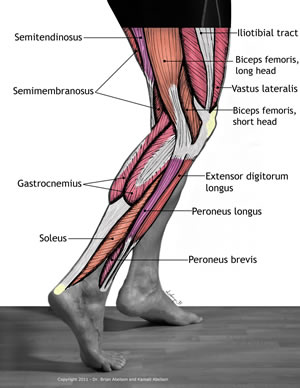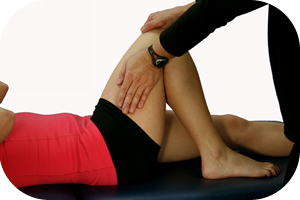Resolving Knee Injuries
 Your knee is a complex structure made up of bones, joints, muscles, ligaments, tendons, cartilage, and fascia.
Your knee is a complex structure made up of bones, joints, muscles, ligaments, tendons, cartilage, and fascia.
Your knee plays a vital role in all gait-related tasks and its function is greatly affected by the condition of the soft-tissue structures both above and below the knee.
What Causes Knee Pain
 As a runner and a sports medicine practitioner, I commonly see people with a variety of knee injuries. The causes of the knee pain are varied and often result from a combination of environmental, physical, and physiological factors. Knee pain can be caused by:
As a runner and a sports medicine practitioner, I commonly see people with a variety of knee injuries. The causes of the knee pain are varied and often result from a combination of environmental, physical, and physiological factors. Knee pain can be caused by:
- Repetitive motion injuries.
- Muscle imbalances.
- Trauma.
- Osteoarthritis.
- Tendonitis.
- Ligament injury.
- Meniscus injuries.
- Iliotibial Band Syndrome.
- Osgood-Schlatter Disease.
- Pathological causes, though rare, compared to the more common mechanical causes of knee pain.
These conditions, if left untreated, can often lead to an ongoing cycle of biomechanical imbalances which eventually lead to ongoing pain and degeneration of the knee, as well as hip, low back, shoulder, or neck problems. Remember, our body is organized as a series of structural kinetic chains, where a dysfunction or imbalance in one area can quickly lead to dysfunctions in other parts of the body.
Sometimes surgery is necessary to correct knee problems, but in the majority of cases it is not. By applying the appropriate treatment procedures and rehabilitative programs, most people can not only treat their current knee problem, but can also prevent future knee injuries from occurring.
Resolving Knee Pain
Many common treatment methods often fail to fully resolve knee injuries because they do not address the complex and varying inter-relationships between the various soft-tissue structures that make up the knee.
In the following topics, we take the time to discuss these issues, as they apply to each condition, and show how we can treat these conditions very successfully using a combination of Active Release Techniques (ART) and our unique Functional Exercise programs. These conditions include:
- Patellar Tendonitis or Jumper’s Knee
- Ligamentous Injuries of the Knee
- Meniscus Injuries of the Knee
- ITBS or Runners Knee
- Osgood-Schlatter Disease
Runner’s Knee/ Iliotibial Band Syndrome
 Runners knee is the term given to diffuse pain around the knee, under the kneecap, often with stiffness under the knee joint. It is often related to too rapid increase of mileage, tight hamstrings, and imbalances between the hamstrings and quadriceps. Other physical structures that are often involved include:
Runners knee is the term given to diffuse pain around the knee, under the kneecap, often with stiffness under the knee joint. It is often related to too rapid increase of mileage, tight hamstrings, and imbalances between the hamstrings and quadriceps. Other physical structures that are often involved include:
- Knee capsule.
- Meniscus.
- Collateral ligaments.
- Patellar tendon.
Even the posterior knee is often involved especially a muscle called the Popliteus. This muscle is involved in the rotary stability of the knee.
The Ppsoas muscle is also often involved with knee problems. The Psoas muscle is the primary hip flexor, when this muscle becomes shortened, fibrotic, or weakened, the Quadriceps (Rectus Femoris) has to exert more force to make the hip flex. This is a major (and often undiagnosed) cause of unresolved knee pain.
How can ART resolve Knee Injuries?
 See the following topics for more information about ART and Knee Injuries:
See the following topics for more information about ART and Knee Injuries:
